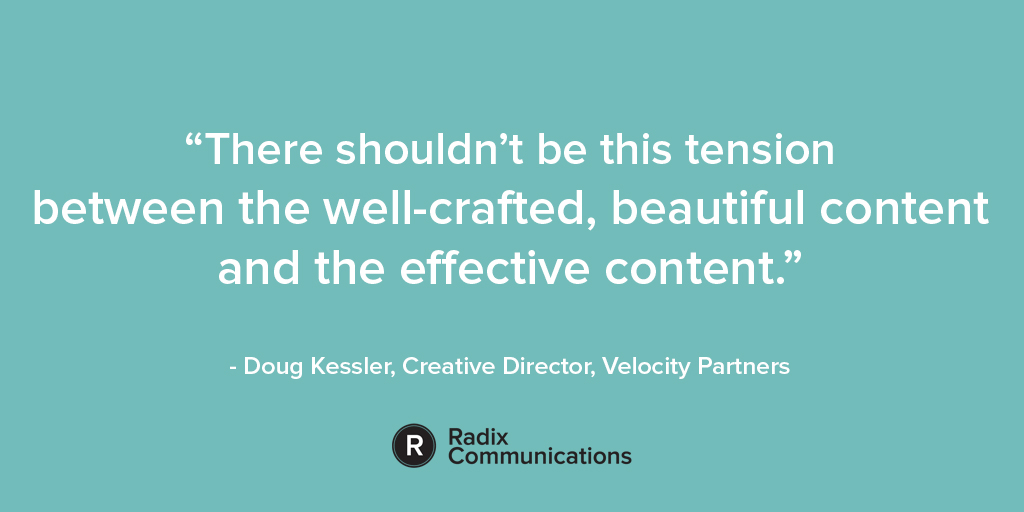Uncooperative departments and a lack of stakeholder alignment are among the biggest obstacles B2B content marketers face. Our Barriers to Great B2B Content study showed 86% have a problem with departmental co-operation – and that if your business isn’t working together, there’s every chance the content you publish will suffer as a result.
So it’s no surprise that the first topic we were asked to cover in our B2B Content Tuesday Q&A webinars was how to create a strong content culture and get your whole organisation engaged.
In this blog post, we’ve outlined eight engagement ideas for you to steal, adapt or ignore. We’ve either seen them work for B2B tech clients, or they’ve been suggested by experts like Maureen Blandford and Doug Kessler. We’ve also summarised some of the questions and answers from the discussion.
If you’d like to watch the session in full, you’ll find a video at the bottom of this post.
Eight ways to get B2B departments more engaged in marketing content
- When you talk to your subject matter experts, keep it focused. Many find marketing a bit vague (or even untrustworthy), and asking for a “chat” will add to that. Instead, give the expert a list of questions in advance, so they get the comfort of preparation and their time and involvement is clearly defined in advance.
- Make it part of a clear content plan. Establishing a well thought-out content initiative can help subject matter experts feel like they’re taking part in something concrete, and will help them stay on board.
- Treat stakeholders like customers. In our study, experienced tech marketer Maureen Blandford said she does her research, and when she approaches stakeholders, only talks about their business needs, values or interests – and how she can help.
- Ask subject matter experts questions you already know they’ll like. Experts like to share their knowledge – it might only be the marketing context that’s making them uncomfortable. So help them feel like they’re on their home turf, and you’ll likely get better answers.
- Find bright spots in each department. Not everyone distrusts marketing – so start by looking for quick wins. Find the people who like engaging with you, and you’ve hit gold. Plus, when their colleagues see how easy working with marketing can be, and all the good things that result, you’ll get more interest from them too.
- Be really, really (really) clear on what good content looks like. If you don’t have a clear standard in your organisation, everyone will nitpick everything. At Radix, we standardise content reviews using a B2B content checklist, which you can steal and adapt if you’d like to.
- Back up your content opinions with data. If you can show evidence about what content works, you’re more likely to keep the conversation in areas where other departments can really help.
- Use their time well. As much as possible, focus on making people do the bit that you can only get from them – the nugget of wisdom or viewpoint that only they have. Good research (and dare we say good copywriters) can fill in the rest.
Q&A: Establishing a B2B content culture
Q: How do I get colleagues involved while everyone is working remotely?
David: “Sensitively. It might be that people are feeling isolated, and would quite like a chat about something, but don’t assume that nobody is busy right now.
“If you’ve had to cancel a marketing event where subject matter experts were going to speak or run an exhibition stand, you’re handing them back a day’s worth of time. So that can be a really good point to ask to borrow half an hour, where you can find out exactly what they want to say and get them to brief a copywriter or in-house writing team.
“But unless you’re specifically giving them hours back by cancelling something, don’t assume they have loads of time.”
Q: People I need for content aren’t responding to email – how can I get through to them?
David: “There are just TONNES of emails around at the moment, and our inboxes are all full of companies emailing us about how they are there for us at this ‘difficult time’.
“So pick up the phone, or jump on a Zoom call. Being able to see people’s faces is really helpful when you’re trying to figure out what they’re dealing with.”
Q: At Radix, how do you define good content beyond achieving the client’s business goal?
David: “That’s the number one – the ultimate ‘did it work, yes or no?’ But unfortunately, we writers don’t always get to find out if our content achieved its goals. Clients are so busy that they often don’t circle back to us with the results.
“When we’re reviewing internally, we use a clear, 16-point quality assurance checklist. Before any content goes to the client, it is assessed by another writer, and we’ve tried to standardise that process as best we can – so we know we’ve covered aspects like readability, technical accuracy, and voice.”
(You can find the checklist here – feel free to steal it for yourself.)
Q: How do you reconcile different ideas of good content – data, emotional impact, and perceptions of what different audiences expect?
David: “Emotion is always important – but you do still need to be clear, and use data to your advantage.
“When someone says: ‘our technology is very complicated, our audience is very intelligent – why are you writing in a way that’s so simple?’ bring them back to the facts. Show them the number reading on a mobile device – with the extra cognitive load that entails – or the proportion of your audience reading in a second language. When you’re talking about what good content looks like, you need to have evidence.
“For example, case studies that specifically name the client and have a quote are statistically more successful than those that don’t. So if you’re talking to a salesperson who doesn’t want to put you in touch with a customer, your data can give them clear evidence that by getting that interview you can help them to sell more.
“When it comes down to defining good content, move away from your opinion vs their opinion – especially if there are good, data-driven reasons to do it your way.
“Remember, the stakeholder will usually last have had their content reviewed in school or university. So to them, the writing that got good marks involved passive voice, reeeeaaaally long words and generally showing off a bit. People internalise that as ‘good writing’, and when they go to work, they think their writing has to put a tie on. So your first job is to reset that – which is where data helps.”
Q: As a content writer talking to subject matter experts, how do you guide that conversation to make use of your storytelling expertise without getting bogged down in technical detail?
David: “One of the things that helps us, is that we work in specific, technical niches. So if someone wants to talk to us about a technology or subject, we’ll generally have a writer who understands the area. We’ll never be technical experts, but it gives us just enough to ask the right questions.
“But in that interview, the most important thing is to know and explicitly represent your audience. If the subject matter expert is talking about things your audience wouldn’t be interested in, it gives you licence to gently guide them away from that.
“That makes it essential to do your homework. Especially if they’re a technical expert writing to another technical expert.”
Thanks again to everyone who attended the webinar, and took part in the Q&A. Here’s the full discussion:
If you’d like more, we’re building a playlist of all our B2B Content Tuesdays webinar recordings on YouTube.



